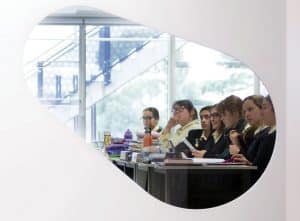In the rhythm of a school, there is no period when great results are more sharply the focus than at the end of the year. This is true for students and for those parents and teachers who have worked together, made sacrifices and invested much effort to achieve an outcome. It is true for us here at Strathcona.
Now, two months later, it is easier to reflect unemotionally on what these results mean.
After months of hard work, and for our VCE students after many years spent focused on an end, they finally got to know “the outcome.”
With VCE results and other exam results known, minds quickly turned to evaluating and categorising performances, deciding whether they were “good or bad.”
Where am I ranked? What was my best subject? Which school performed best? These are the questions that are asked by many, as results are released and the inevitable forensic evaluation commences, both at an individual and at a collective level.
Are these the questions we should be asking? Are there others that may prove more enlightening?
VCE results and exam results are important.
VCE results, great VCE results more specifically, will be the key topic of discussions in schools well into 2018.
Do they matter? Of course they do.
Our young girls have much riding on the results that mark the culmination of their school years. A great VCE result is also a personal affirmation which can reinforce an individual’s confidence and sense of identity in a world that we know is increasingly competitive and results oriented.
At Strathcona, we are immensely proud of the VCE performances of our girls and can highlight some truly impressive results from many individuals and across our school.
Our Dux, Harriet Grimsey, Deputy School Captain, achieved an ATAR of 99.65. Harriet worked hard while also remaining very much engaged in a broad range of co-curricular activities.
The Class of 2017 achieved seven perfect study scores of 50 across five subjects. These include: Harriet Grimsey (Psychology), Isabella Hunt (English), Olivia Muirhead (Physical Education), Yao (Nancy) Ni (Chinese First Language), Raffaela Skourletos (English), Sarah van der Hock (English) and Sarah van der Hock (Health and Human Development).
We are extremely proud to have had nine students (10%) placed with ATARs of 99 and above. 49% (43 of our students) achieved an ATAR of 90 and above, thus placing them in the top 10% in the state.
These outcomes are legitimate reasons for celebration and should, quite rightfully be applauded.
But there is more to it than just the headline results.
Great results for schools must be considered holistically
So, what is a great result? To place a context around the evaluation of results we need to consider our purpose as a school. Why are we doing all of this? What is the ultimate result we want to achieve through investing so much time and effort?
At Strathcona, our purpose is to develop young women who go out into the world prepared for life. We want them to leave the safety of our walls with a mix of skills and experience that will fuel their resilience and ability to take on life’s challenges, the social networks that can support and empower them and the confidence and belief that when they put their mind to it, anything is possible. We also want them to have good character and a strong social conscience.
In this context: what is a great result? Consider the following.
Recently a Strathcona student named Meg, had been a competitive swimmer and didn’t take her academic studies very seriously, not caring too much about grades or marks, achieving average results and tending to go with the crowd, rather than lead, through most her schooling.
At the start of her final year, Meg listened intently to an inspirational first lesson and decided then that she didn’t want to cruise and procrastinate but rather to take on the year in a steady, consistent way. She did not want to be faced with the question of ‘have I achieved my best?’. Meg carefully balanced her swimming for the year with a commitment to her studies. To do this she employed the self-discipline learnt through her swimming training and directed it to her learning. She regularly got up at 5.30 am in the morning to write practice essays. She even set up group brainstorming sessions through the year so that whomever was around could come and mind map ideas for the text each week.
Meg achieved a 50 in English and helped those around her at the same time. This is a great academic result of course, but with many layers of development beyond the raw test score that may ultimately prove more powerful influences in Meg’s future life.
As a school, considering our “bigger picture” responsibilities, I submit that Meg’s achievement is more complex to understand than by simply considering the impressive final result. A focus on test scores just doesn’t reveal fully the depth and breadth of development and it is disappointing that this is not represented more strongly in media reports.
Girls’ schools provide a powerful environment for all round development
In a school where teaching is tailored to girls and in a learning environment where they are surrounded by girls, female students flourish. That is fact. The evidence shows clear differences between girls educated in co-ed environments compared to girls who attend girls’ schools such as Strathcona.
In a girls’ school;
- Girls are less constrained by gender stereotypes and any limitations these might impose
- There is less disruption and female voices are encouraged, heard and respected
- All leadership positions are held by girls, providing excellent examples for other girls to follow and reinforcing the confidence to aspire
- Girls become are confident in their Mathematics, Science and Technology Studies
- Young women achieve significantly higher university entrance scores
The VCE results achieved by our Strathcona girls should receive the praise they so richly deserve and we congratulate all the girls who have now completed their final year of school. Their teachers also deserve commendation.
We know that there is so much more to achievement than just the headline scores and leagues tables, however, considering the compelling evidence for the way in which girls flourish in girls’ schools and then go on to achieve strongly at university and contribute so richly to the world across diverse areas, can we envisage a time when Strathcona becomes co-ed? As I said in my speech at the presentation night in December last year: not on my watch!
Marise McConaghy, Principal


